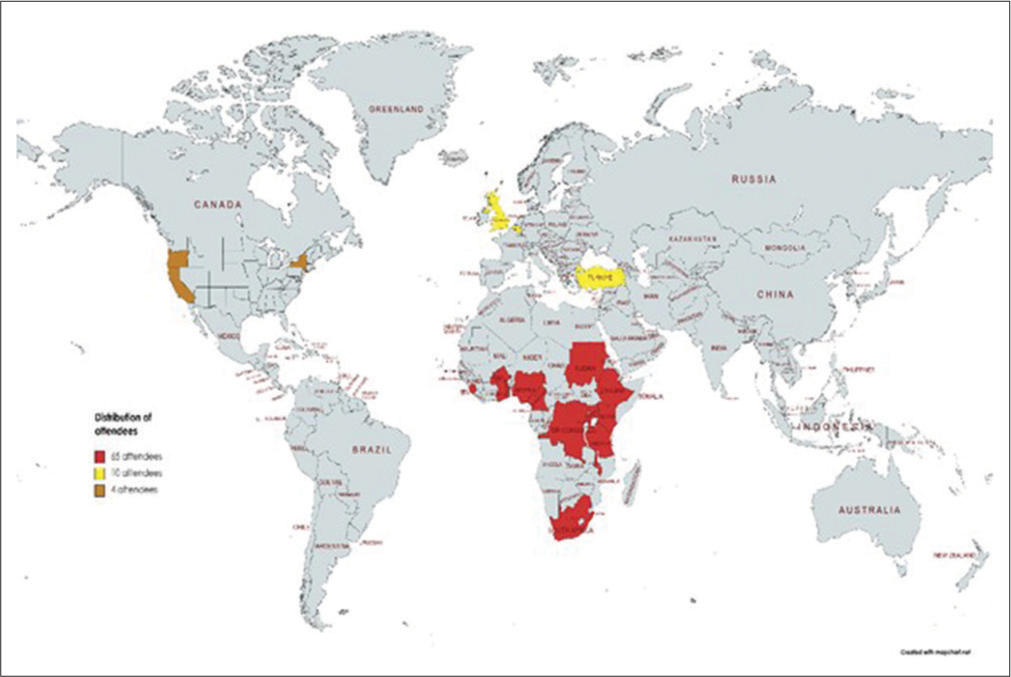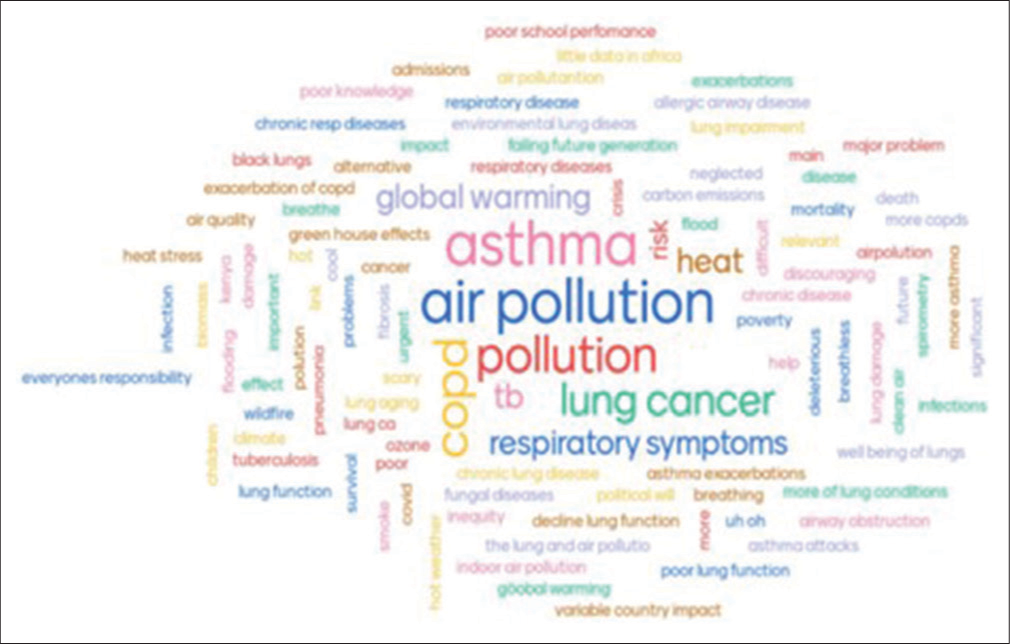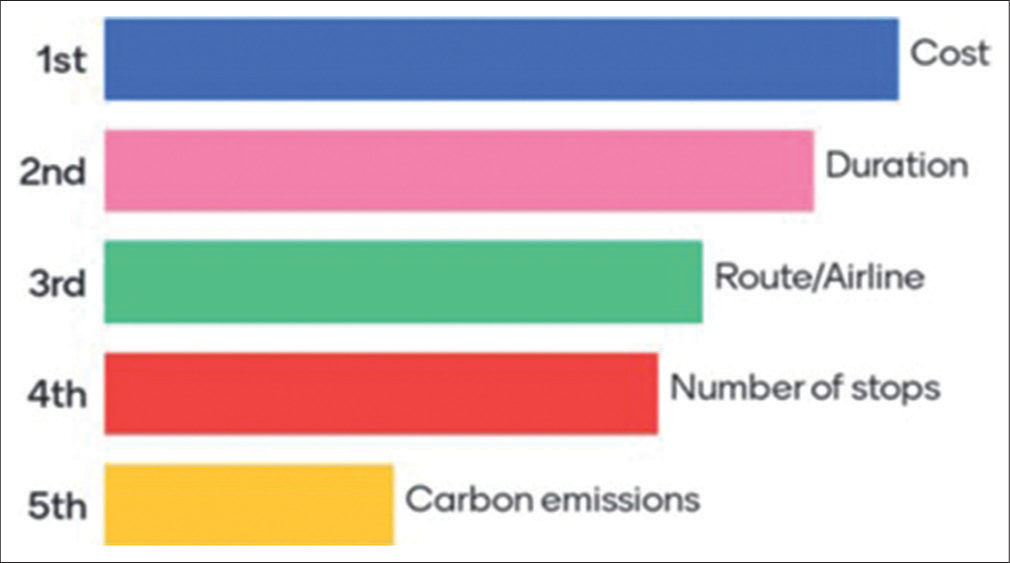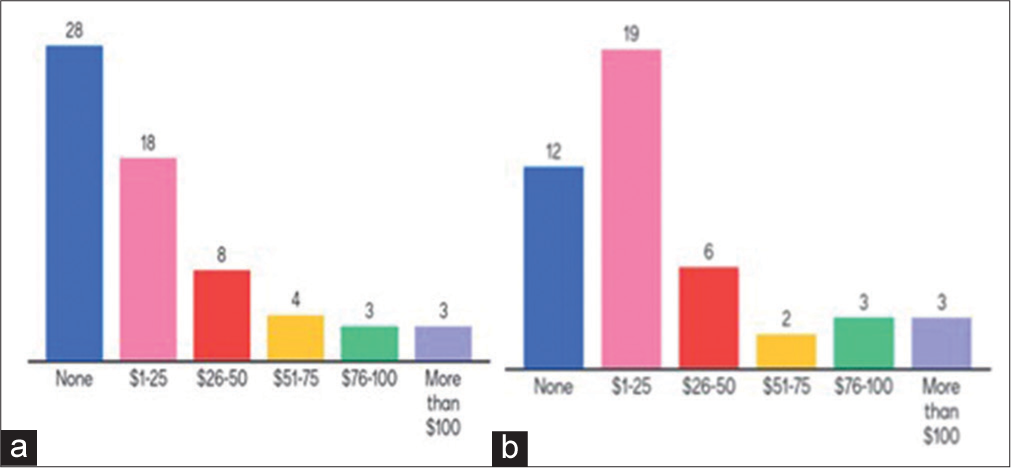Translate this page into:
The flight-related carbon footprint of the Pan-African Thoracic Society (PATS) methods in epidemiologic, clinical and organizational research (MECOR) course 2023
*Corresponding author: Zaheer Bagha, Department of Internal Medicine, Coast General Teaching and Referral Hospital, Mombasa, Kenya. zbagha@yahoo.com
-
Received: ,
Accepted: ,
How to cite this article: Bagha Z, Ayo-Olagunju T, Feyisara K, Obiefuna AG, Mortimer K, Semple S. The flight-related carbon footprint of the Pan-African Thoracic Society (PATS) methods in epidemiologic, clinical and organizational research (MECOR) course 2023. J Pan Afr Thorac Soc. 2024;5:11-6. doi: 10.25259/JPATS_21_2023
Abstract
Objectives:
Climate change is a worldwide public health emergency, and traveling by plane results in the emission of carbon dioxide (CO2), which plays a major role in global warming. This study sought to measure the flight-related carbon footprint of the Pan African Thoracic Society (PATS) Methods in Epidemiological, Clinical, and Organizational Research (MECOR) 2023 course. It looked at whether providing feedback on emission information to attendees would affect their attitudes about flight choices.
Materials and Methods:
We conducted a cross-sectional descriptive study at the PATS MECOR 2023 training program whereby the flight itineraries of all attendees were used to estimate the total carbon emission for each participant’s return journey to Mombasa, Kenya, using the Google Flight tool. An electronic survey was conducted on consecutive days to measure the knowledge, attitude, and practices of respondents before and after feedback on the aggregated emissions estimate.
Results:
The estimated total flight-related emissions of the 80 attendees were 57 tonnes of CO2. The primary determinant of choice of flight among most respondents was cost, and the least important was carbon emission. Only 22% of respondents correctly estimated that the total carbon footprint exceeded 30 tonnes. The proportion of attendees prepared to offset their carbon footprint increased from 54% to 73% before and after being informed of the delegates’ estimated CO2 emissions, but the change was not statistically significant (P = 0.07).
Conclusion:
Hosting a major international conference produces a carbon footprint, which, if measured and shared with funders, organizers, and attendees, can help inform the debate about how to reduce and mitigate this important contributor to global climate change.
Keywords
Climate change
Carbon footprint
PATS MECOR
INTRODUCTION
There are many ways that climate change impacts health, both directly from heat stress, flooding, and drought as well as indirectly due to food insecurity, undernutrition, and water insecurity. There is an increasing awareness that the climate emergency is also a public health emergency. The emission of carbon dioxide (CO2) and other greenhouse gases is now accepted to play a significant role in global warming, with many countries committing to greenhouse gas emissions of net zero by 2050.[1] Since the energy sector contributes to three-quarters of greenhouse gas emissions, net zero could be achieved by utilizing renewable energy sources for power, such as wind and solar, instead of coal, gas, and oil.[1]
The carbon footprint of an activity or process is typically used as an indicator to quantify CO2 emissions or greenhouse gas emissions in units of CO2 equivalents.[2] The Intergovernmental Panel on Climate Change defines carbon footprint as the “measure of the exclusive total amount of CO2 emissions that are directly and indirectly caused by an activity or are accumulated over the lifecycle stages of a product.”[2]
Route selection can modify the CO2 emissions for any given flight. Analysis of the 20 busiest domestic flight routes in the USA has demonstrated that the least-emitting choice on a route can, on average, produce 22% less CO2 than the route average and 63% less than the most-emitting option.[3] Choosing business class versus economy results in higher CO2 emissions since the larger the space occupied on the plane, the bigger the carbon footprint. Carrying more luggage also increases the carbon footprint since the heavier the aeroplane, the more fuel it consumes. These data suggest that encouraging passengers to consider the emission profile of their journey flights could help achieve considerable CO2 emission reductions.[3]
The carbon footprints of the delegates at the American Thoracic Society’s (ATS) annual conference, which was held in San Diego in 2006, were previously calculated.[4] The travel of 14,914 delegates resulted in the production of 10,799 tonnes of CO2. A more holistic evaluation of the International Federation of Medical Students Associations (IFMSA) General Assembly in Montreal in 2018 considered CO2 emissions from travel, accommodation, catering, materials, and waste and estimated a “footprint” of 1902 tonnes of CO2, of which 1607 were estimated to arise from travel, including flights.[5] Leddin et al. estimated the travel-related CO2 emission of attendees at the Annual Meeting of the Canadian Association of Gastroenterology to be 0.54 tonnes of CO2 per person when held in Toronto compared to 0.76 tonnes when convened in Banff.[6]
The carbon footprint associated with hosting the Pan African Thoracic Society (PATS) annual training Methods in Epidemiological, Clinical, and Organizational Research (MECOR) program is unknown. We set out to estimate the flight-related carbon footprint of PATS MECOR 2023 and explore whether providing feedback on this estimate to attendees would affect their attitudes about flight choices, which would have lower CO2 emissions based on routes and class of travel as well as toward carbon offsetting.
MATERIALS AND METHODS
Study design
This was a cross-sectional observational study.
Participants
The carbon footprint was calculated for 79 attendees who took a flight(s) to attend the PATS MECOR 2023 course. A survey of those course attendees present at the morning plenary sessions was carried out; 65 attendees participated in the initial survey, while 45 took part in the post-survey to assess changes in attitude following awareness about the burden of the course’s carbon footprint. The reduced number of participants in the follow-up survey is likely to have been due to the fact that not all MECOR students/faculty attended the two sessions on both days.
Variables
Total flight-related carbon emission of the participants in tonnes.
Data collection and analysis
The anonymized flight itineraries of all 2023 PATS MECOR attendees were obtained from the administrative section of the organizing committee. The Google flight[7] tool was used to estimate the total round trip carbon emission for each participant at 2023 PATS MECOR. An assumption was made that all participants flew economy class. A central location in each person’s country, state, or province was chosen to determine the route. This was entered on Google flight to identify the possible aircraft used on each flight based on the schedule of the booking details. The estimated CO2 emission (in kilograms) for a round trip using that route and selected aircraft was recorded. By checking the airline and route with the least carbon emission on Google Flight, the lowest possible carbon emission was also estimated for each participant if they had chosen to travel by that airline and route.
The data generated were imputed on a Microsoft Excel[8] sheet to get an aggregate of the carbon footprint of all attendees. The attendees received a brief explanation of the study at the start of data collection, and participation in the survey was viewed as consent. A short web-based survey was conducted to determine the knowledge, attitude, and practice of PATS MECOR participants. This was carried out on two consecutive days (before and after participants’ awareness of the impact of their carbon footprint) using the online Mentimeter[9] tool, which provides anonymized responses.
Bias
There was a risk of error due to the assumptions made regarding the class of flight as well as the routes of some of the attendees.
Ethics
Ethical approval was not sought as no personal details were collected from the participants, and no procedure or intervention was involved. Hence, verbal consent was taken before the start of the survey, and participation was voluntary.
RESULTS
Seventy-nine of the 80 attendees flew into Mombasa for PATS MECOR 2023, except for one person who was a resident of the city and arrived by car. The majority (80%) of the participants arrived from other African countries (n = 65), 13% (n = 10) from Europe, and 5% (n = 4) from North America [Figure 1].

- Locations of origin of the Pan African Thoracic Society MECOR 2023 attendees.
The estimated total carbon footprint was 56.6 tonnes of CO2. If the participants had chosen the airlines and routes with the lowest possible carbon emission the figure estimated was 45.2 tonnes. To put this in local context, the total annual per capita CO2 emission for Kenya in 2020 was 0.3 tonnes.[10]
In the first Mentimeter survey, when the participants were asked to identify what came to their mind regarding climate change and lung health, two terms that resonated with many attendees were “pollution” or “air pollution” [Figure 2].

- Responses when participants were asked, “What comes to mind regarding climate change and lung health?”
When asked to rank the considerations for planning flights to attend PATS MECOR 2023 in order of priority, the primary determinant for choice of flight among most attendees was cost; CO2 emission was the least important consideration [Figure 3]. When asked to estimate the aggregate PATS MECOR 2023 carbon footprint, only 12/55 (22%) of respondents correctly predicted that the estimated carbon footprint was greater than 30 tonnes [Figure 4].

- Determinants of choice of flights for participants.

- Estimates of Pan African Thoracic Society methods in epidemiologic, clinical, and organizational research 2023 carbon footprint by participants.
36/64 (54%) and 33/45 (73%) of attendees were prepared to pay at least $1 toward offsetting their carbon footprint before and after being informed of our estimate of the total CO2 emission [Figure 5]. There was no statistically significant difference in the proportion of delegates willing to offset their carbon footprint after the feedback session (Pearson Chi-square: 3.32; P = 0.07).

- (a and b) Financial commitments toward offsetting the flight-related carbon dioxide emission before and after providing participants with an estimate of the carbon footprint.
DISCUSSION
A total of 80 people attended PATS MECOR 2023 in Mombasa, Kenya. The estimated total carbon footprint was just under 57 tonnes, equivalent to 712 kg of CO2 per attendee. To put this in context, the total annual per capita CO2 emission (for all sources, including travel, household energy, and product consumption) in Kenya in 2020 was 0.3 tonnes.[10]
Callister and Griffiths[4] reported the carbon footprint for 14,914 delegates for the 2006 ATS international conference held in San Diego in 2006 to be 10,799 tonnes, equivalent to 725 kg of CO2 per attendee.
Zotova et al.,[5], in their study, noted that the travel-related (flights as well as cars) carbon emission of 900 delegates from over 100 countries attending the General Assembly of the IFMSA in Montreal, Canada, was 1,646.53 tonnes, which came to an average emission of 1.83 tonnes/person.
The lowest possible travel carbon footprint by choosing the airline and route with the lowest possible carbon emission would have produced a 21% reduction in CO2 emission. This suggests that by choosing different flight routes and aircraft combinations, PATS MECOR delegates could have reduced the CO2 emissions of their journey to the conference.
Most of the participants in our study agreed that climate change and lung health are significant issues that should be addressed in Africa. Some words that they considered important when they thought about this issue included: “Air pollution,” “chronic respiratory diseases like asthma and COPD,” and “lung cancer.” This likely reflects the academic and professional background of the delegates, and a different group may highlight other terms.
Most attendees underestimated the CO2 emissions of flying, as only about a fifth of them estimated that the total carbon footprint of the delegates’ travel to the conference exceeded 30 tonnes. Cost, not surprisingly, as is the case with many low- and middle-income countries where most of the participants attended from, was the primary determinant in their choice of flight. Another important consideration was the duration of the journey. CO2 emissions were at the bottom of the list of priorities and remained there even after the CO2 emission estimate was provided before the second survey.
While there was a positive shift in the attitude of the participants regarding financial commitments toward offsetting the flight-related carbon emission of the program after furnishing them with initial data on our findings, the change was not statistically significant. This could be due to a small sample size and insufficient power to detect a statistically significant change, an inadequate understanding of what carbon-emission offsetting means, a lack of awareness of methods available for offset, and/or the cost implications involved.
Simply providing health professionals with information about the CO2 footprint of their flying activity may not be a strong enough behavioral change tool. Other methods of encouraging change in route or aircraft selection and/or making the initial decision to fly should be explored, such as providing emission data as well as options for different methods and incentives for carbon offsetting during the ticketing process. It looks as though cost and price are likely to be the primary driving factor in decision-making around work-related travel. This mimics findings for other behaviors studied in public health; for example, price is one of the key tools in limiting tobacco and alcohol consumption.[11]
Certain travel search engines, such as Google Flights, Kayak, and Skyscanner, have incorporated “eco-flight filters” into their platforms. These show flights with lower-than-average CO2 emissions across all search results. Making emissions data available may aid consumers in making choices to reduce their CO2 footprint.[3]
Considerations to reduce the carbon footprint may include providing attendees prior information about flying and carbon emission, maximizing virtual participation and/ or video conferencing where possible, and including the option of purchasing carbon credits during course payments. There are several methods proposed for lowering CO2 emissions that can be utilized as offsets, including wind energy, the use of clean cookstoves, landfill methane, forestry, and other programs that avoid or reduce emissions caused by forest degradation and deforestation.[12] Some ways to reduce CO2 footprint when traveling abroad include:[13]
Selecting more eco-friendly airline that uses renewable biofuels
Taking a direct flight rather than changing at hub airports
Donating to organizations involved in CO2 offsetting
Traveling in economy class
Traveling light (the more weight an airplane carries, the more fuel it consumes).
In 2021, the aviation industry pledged to aim for net-zero carbon emissions by 2050. This commitment aligns air travel with the Paris Agreement’s goals of keeping global warming below 2°C.[14] Net zero emissions by 2050 will require efforts toward the collection of CO2 emission data, offsetting, and maximal source-to-point emissions reduction.[15] To be successful, it will take concerted efforts from every sector of the industry (airlines, airports, providers of air navigation services, and manufacturers).
The strengths of our study include that it was simple, did not have any extra financial implications, and could be replicated by all major medical conferences, providing an estimate of their flight-related carbon footprint. It creates awareness and generates important debate around the contributions of medical conferences to global warming and is a valuable initial step from an advocacy point of view.
Our study also had limitations. It focused only on flight-related CO2 emissions; therefore, it is not a full assessment of the total carbon footprint of each participant. Second, the estimates provided by Google Flights do not take into account the effect of altitude on CO2 emission (radiative forcing), hence not a total reflection of the flight-related carbon footprint. In July 2022, Google decided to remove all aviation-related global warming effects from their search engine, except for direct CO2 emissions.[16] As a result, its calculations now underestimate the overall impact of aviation on the climate, which is now slightly more than half of what some experts think to be the true impact of flights on the climate.[16] Finally, there were 64 participants involved in the baseline Mentimeter survey and only 45 in the follow-up survey, making it difficult to compare the absolute numbers of responses to the questions.
CONCLUSION
Climate change is a global health problem, and its harmful effects on lung health have been well documented. We have shown from our study that a considerable amount of CO2 emission is associated with hosting a major program like PATS MECOR.
Measuring and publishing the carbon footprint of medical conferences enables the identification of carbon reduction opportunities. This will encourage the development of a strategy to monitor and reduce the PATS MECOR carbon footprint, such as setting annual reduction targets. The onus is on us as medical professionals to ensure that environmental sustainability is central in planning these events.
Ethical approval
Institutional Review Board approval is not required.
Declaration of patient consent
Patient’s consent not required as there are no patients in this study.
Conflicts of interest
There are no conflicts of interest.
Use of artificial intelligence (AI)-assisted technology for manuscript preparation
The authors confirm that there was no use of artificial intelligence (AI)-assisted technology for assisting in the writing or editing of the manuscript, and no images were manipulated using AI.
Financial support and sponsorship
Nil.
References
- Climate action. For a livable climate, Net-zero commitments must be backed by credible action. Available from: https://www.un.org/en/climatechange/net-zero-coalition
- [Google Scholar]
- A definition of ‘carbon footprint’ In: Pertsova CC, ed. Ecological economics research trends. United States: Nova Science Publishers; 2008. p. :1-11.
- [Google Scholar]
- US domestic travelers could choose low-emission flights - if data was available. 2021. The Guardian. Available from: https://www.theguardian.com/environment/2021/jul/22/airlines-us-travelers-low-emissions-pollution
- [Google Scholar]
- The carbon footprint of the American Thoracic Society meeting. Am J Respir Crit Care Med. 2007;175:417.
- [CrossRef] [PubMed] [Google Scholar]
- Carbon-neutral medical conferences should be the norm. Lancet Planet Health. 2020;4:e48-50.
- [CrossRef] [PubMed] [Google Scholar]
- The carbon cost of travel to a medical conference: Modelling the annual meeting of the canadian association of gastroenterology. J Can Assoc Gastroenterol. 2021;5:52-8.
- [CrossRef] [Google Scholar]
- Per capita CO2 emissions in Kenya from 2000 to 2020. 2022. Statista. Available from: https://www.statista.com/statistics/1287769/per-capita-carbon-dioxide-co2-emissionsin-kenya
- [Google Scholar]
- The role of public policies in reducing smoking prevalence and deaths: The Argentina Tobacco Policy Simulation Model. Pan Am J Public Health. 2007;21:37-49.
- [CrossRef] [PubMed] [Google Scholar]
- Carbon offsetting for international aviation. 2020. Available from: https://www.iata.org/contentassets/fb745460050c48089597a3ef1b9fe7a8/paper-offsetting-foraviation.pdf
- [Google Scholar]
- 8 ways to reduce your carbon footprint when travelling abroad. 2022. Energy Live News. Available from: https://www.energylivenews.com/2022/02/25/8-ways-to-reduce-your-carbon-footprint-when-travelling-abroad
- [Google Scholar]
- Climate action. The Paris agreement. Available from: https://www.un.org/en/climatechange/paris-agreement
- [Google Scholar]
- Our commitment to fly net zero by 2050. Available from: https://www.iata.org/en/programs/environment/flynetzero
- [Google Scholar]
- Google ‘airbrushes’ out emissions from flying. 2022. BBC reveals, BBC News. Available from: https://www.bbc.com/news/science-environment-62664981
- [Google Scholar]






